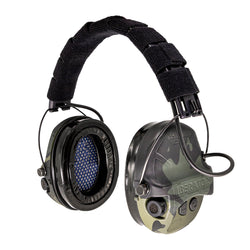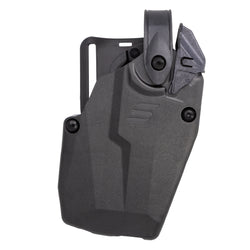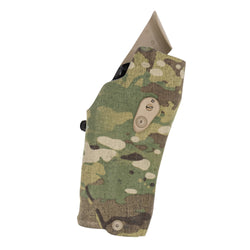The 12 gauge shotgun has seen a resurgence of interest in recent years. Companies like Beretta and Mossberg have created reliable semi-automatic platforms capable of delivering a wide range of ammunition for a number of needs. Buckshot, slugs, breaching, and bean-bag rounds are all commonly carried and provide the user a broad spectrum of options.
For those new to firearms, it is common to assume the practices used for handguns and rifles transfer to the shotgun, but the shotgun requires certain understanding.
Dubbed “the thinking man’s gun,” the shotgun can be finicky and cause user-induced malfunctions. Only through dedicated training and time behind the gun can the best practices be found.
Some of the best lessons are learned from issues experienced in courses. What follows are some of the lessons better learned in controlled conditions than the chaos of reality.

Download Capacity by One
The Beretta A300 Patrol has become a popular shotgun in the tactical/home defense world. Considered an alternative to the 1301 Tactical, the A300 has been called “90 percent of the 1301 at 60 percent of the cost.”
The A300 has a manufacturer-listed capacity of seven plus one. The temptation is there to chamber load and then top off the magazine tube for a total capacity of eight rounds. Another popular option is to keep the chamber empty but the magazine tube full. The problem with both of these is twofold. If the shotgun is loaded only with buckshot but a slug is needed, the only way to load a slug is to lose rounds to the ground.
Downloading the magazine tube by one allows the user to simply load a slug into the magazine, run the bolt, and quickly select the slug for further targets.
The other problem with full-capacity loading is the weakening of the magazine tube spring. According to Cody Stewart from Vang Comp Systems, the magazine tube is a weak spring compared to those found in pistol and rifle magazines. Left fully loaded, a shotgun spring will lose strength in about a year. Downloading by a single round helps preserve the integrity of a magazine tube spring.
Carry Ammunition Wisely
The 12 gauge shotgun runs out of ammunition very quickly. Despite delivering eight or nine .33 caliber projectiles simultaneously downrange per shell fired, shotguns typically do not hold anywhere near as many rounds as a pistol or rifle. It makes sense to carry spare ammunition on the receiver or on the stock of the shotgun in some combination of slugs and buckshot.

Placing spare ammunition on the receiver moves critical reloads closer to the ejection port for combat loading.
Buttstock carry isn’t terrible, but it does require further travel of your support hand to access ammunition and more time between reloads.

How the shells are carried matters, too. Brass up carry works well with over-the-receiver reloading. Brass down works well for accessing rounds to insert through the loading port.
Elastic side-saddle placards work well for placing spare ammunition on the receiver with hook and loop tape. They are also easy to swap out when the ammunition carried is used.
Spare placards can be carried in some M4 magazine pouches, and they will fit in many sap pockets found on uniform pants.

Press Check and Proof Mark
The concept of press-checking should be familiar to the readers of this blog. Press checking ensures the status of the firearm. Press checking can take place not only at the chamber but also from muzzle to buttpad.

Anytime a shotgun is accessed, the weaponlight should be tested. While modern LED bulbs are more durable than incandescent lights of the past, the attachment method may have loosened.
While at that end of the shotgun, the user should also double-check check the magazine tube cap or extension is properly secured. It is good practice to use a paint pen to witness mark the cap against the ring on the barrel that fits over the magazine tube.

The same witness marks should be used on any screws like those on top of the receiver securing red-dot optics in place.
Of course, the chamber can be checked visually and physically to ensure the status of the firearm.
One additional press check that should be conducted is the attachment of the sling to the firearm. Make sure that it is secure and that the sling is stored in a manner that doesn’t interfere with the rest of your gear.
Pattern the Buckshot Carried
Anytime a person states, “You can’t miss with a shotgun” or “You don’t even need to aim with a shotgun,” the immediate reaction should be disagreement.
Traditional knowledge states that buckshot will spread approximately one inch for every yard in a growing cone from the muzzle. This pattern can be consistent, but nowhere near as consistent as the inconsistency among firearms.
One particular buckshot load will work well with one firearm but not with another. Two exact model shotguns can have two different performances with the same ammunition. Some barrels will consistently pattern one flyer to somewhere on the target around the metaphorical clock.
The only way to determine how a shotgun performs with ammunition carried is to use ammunition carried. While it is tempting to purchase budget ammunition, it is a disservice to the user to assume cheap ammo works the same way as premium.
Generally speaking, Hornady Critical Duty and Federal Flite Control seem to improve performance in any firearm used. Paired with Vang-Comp porting, it isn’t uncommon to see buckshot stay on a human silhouette target out to 25 or 30 yards. Considering the internal dimensions of most houses are shorter than this distance, it gives the user an understanding of how far a shotgun can be used before pellets are thrown off the target.

One final word on patterning, if a shotgun is equipped with a “donut and dot” type optic, it is good practice to know at what range the pellets will be contained on the target inside of the reticle superimposed over it.
Unload without Chambering
The difference between a negligent discharge and an accidental discharge is the driving force behind the discharge.
- Mechanical failures are accidental.
- Human error is negligence.
With a shotgun, mistakes can create significant property damage and serious personal injury.
A shotgun cannot fire with an empty chamber, and yet many users are content loading to unload by racking the slide or running the bolt of their 12 gauge.
Accidents happen, but they can’t happen if you don’t put your shotgun in a condition or status to cause one. Rather than jacking the action repeatedly, it is safer to depress the shell stops inside the receiver to remove the loaded rounds in the magazine through the loading port.

Once the magazine is unloaded, the chamber can be unloaded on some shotguns. For others, the chamber is unloaded first, and then the magazine. It all depends on the shotgun, and this process is best understood by practicing with dummy rounds.
Keep in mind, traditional rifle or pistol training teaches the user to remove the source of feed, open the action, inspect the magwell, bolt face, and chamber. With some shotgun models, you may have to open the chamber first and then remove rounds from the magazine. Again, the shotgun is the thinking man’s gun.

Don’t miss Part 2: mitigate recoil, loading, and more.









